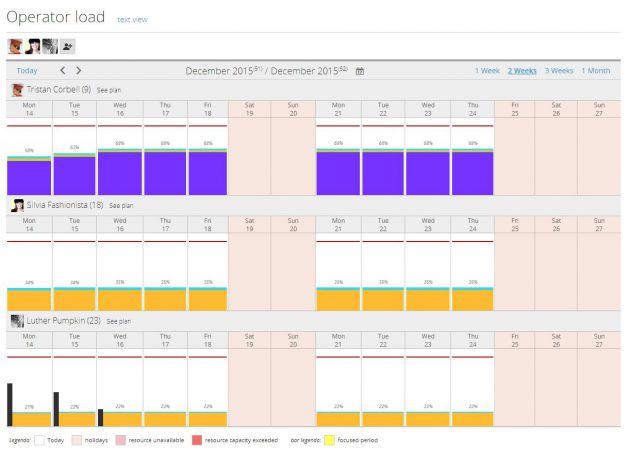Managing the workload of a project, is getting the right balance of tasks for each team member, is one of the most critical tasks that a project manager has to face.
In fact, the equitable distribution of the workload in a team is definitely a challenging task, and the temptation to entrust more projects to the best performing worker is always lurking.
But in the planning of a project, it is also necessary to be fair.
The excellent management of workload and team performance are therefore a essential goals.
CONTENT INDEX
In the continuos dialogue with the Project managers, we receive frequent and common questions:
- What matters to customers and / or stakeholders?
- How is it possible to obtain the best results?
- How is it possible not to overload resources?
- How can resources be used wisely?
- How is it posible to obtain more from low-performing resources?
Here, then, a simple 6-step approach to ensure the correct management of activities and workload within the team.
1. Check the current workload
If you the project is starting from scratch, it is necessary to examine the current situation of the team.
Are the team members also following other projects? What are their other daily activities to keep in mind?
It is possible to manage in an optimal way only what is known.
Some people may be available to work on the project activities just for a limited time of their day / week, on the other hnad, others may be available full-time.
It is therefore essential to know this aspect in details in order to manage the workload equally.
2. Report of skills and absences
It is possible to better manage the workload of the team, if the project manager knows when the individual employees are absent: holidays, company outings, etc.
It is important to include these absences in the planning in order to not assign work during these periods.
Assigning an activity to a resourse that will be out of office or not available will certainly end up in a delay of the delivery.
In the same manner, it is important to speak with each employee in order to be sure to know all of his skills and competencies.
Each person can be a valid “player” if his strengths, skills and responsibilities are well known.
In this way it will be easier to assign an appropriate job and thus move towards excellence.
A collaborator may be able to work in different areas thanks to new knowledge acquired, or to deal with more technical tasks thanks to new skills developed.

Therefore, the suggestion is to cyclically verify the “new skills” learned from the individual collaborator.
Normally, during the planning of the project, a list of all the work and the various activities is drawn up.
The tasks will be assigned according to the function, position and specific strength of each worker.
3. Set expectations
Setting goals and skills is not enough.
The task of the Project Manager is also to constantly remember the pre-established goals and to underline the level of commitment expected from each team member.
This helps the team to focus.
There must be a clearly expressed and shared value to which everyone should equally contribute with his talents, skills and energy.
One of the difficulties in ensuring that a workload is fair is that employees never work at the same pace.
In other words, even when the workload seems “fair and even”, it may not really be that way.
It is important to ensure that employees understand that hours can not be compared with productivity.
In fact, for two hours worked, two employees can produce different results.
The best way to do this is to praise the truly satisfying and successful performance of the project, regardless of the working hours.
A project manager should pay attention to what people are realizing in practice and not just to the number of working hours.
Granted that the time required by a resource to finish a certain activity is not really exaggerated.
4. Identify the overworked staff
This means to identify those resources that have already received more work than they can actually do in the time available.
If a collaborator really has too much work, it is possible to divide the activities into smaller blocks to distribute to several other resources.
Or postpone the deadline of a certain activity in order to lighten the daily workload.
Also for the overall workload management, it is possible to follow the 80/20 rule.
- People should be assigned to specific tasks only for 80% of their time.
- The remaining 20% will be used to answer phone calls, attend team meetings, deal with the clients and so on. This 20% should be distributed evenly throughout the week. It is better to fill people’s time for – for example – 6 hours a day, rather than giving them a fixed day “free” from specific activities.
There may also be the case where a person seems overburdened with work, even if this is not the reality. This can occur when the resource is not able to manage its work efficiently.
There are possible interventions to offer in these cases, such as a coaching with a more efficient colleague or a training course.
But we must also consider the fact that some people do not belong to the jobs they are in and therefore may not be suitable for the task assigned.
In this case, it may be necessary to change the role and function within the organization.
5. Identify the “free” staff
Team members are motivated when their day is full of meaningful tasks.
This makes them feel important for the project.
A time management system will help to understand if the employees are working on priority activities, or in general on activities important for the project, or not.
In some situations, the collaborators themselves can ask for more work. On the other hand, they could also say that they can not take on further tasks.
This is where the workload management capability of a project manager comes into play.
Are the team members really too busy or are they just working on the wrong tasks? What if they were just incredibly unproductive?
Some people do not give the right importance to their work and they do only the bare minimum.
With this kind of people we need to be clear.
They will have to know that the level of commitment could have consequences in terms of the possibility of promotion, financial incentives and prestigious assignments.
The more the team’s strengths and working patterns are known, the easier it will be to correctly manage the workload.
6. Inform about changes in planning
Obviously, even with the best planning, the development of a project may require an immediate change of priorities.
If you intend to change an assignment in the resource planning or workload system, it is absolutely necessary to speak first with the relevant stakeholders and collaborators.
This is one of the main tricks to keep the team happy.
Communication in this situation is essential.
It is necessary to explain the reasons behind structural interventions, as well as to highlight the requisites of the resources needed to complete the project. It is strategic to emphasize the need for a project and not make it a personal issue.
The key points to remember
What to do:
- Spend time on planning in order to reflect on the delegation strategy.
- Create a list of all the activities that need to be done and then assign tasks based on the specific function, position, and strengths of team members.
- Create a culture that enhances productivity beyond the hours worked by openly praising an important and successful performance.
What not to do:
- Being excessively rigid regarding the workload delegation strategy; when priorities change, it is necessary to be flexible.
- Burn the top performer. Before loading him further, identify if and how it is possible to break down a more complex task into secondary tasks.
- Let a collaborator “rest on his laurels”. It is necessary to be clear and direct on the general project expectations, as well as on the personal ones.
There are real risks involved in not distributing the workload fairly.
Indeed, if the high performers are overloaded, they will start to resent the fact that they are doing more than their colleagues, in addition to risk the burn out.
If work is taken away from slower people, they will inevitably lose interest.
People also work to achieve success – albeit small – to grow and to be recognized. When this opportunity is not given to them, the risk is high.
This is why in the Twproject software we paid special attention to managing the workload of each team member.
From the planning phase to the monitoring and control phase, it is possible to have a clear picture of the progress of each collaborator’s work.

For each resource the Project Manager can have a graphical representation of the total load per day, (where each color represents a different task), as well as a detailed explanation of the load components.
The functions available are so many! The best way know them is by testing our software
In our software work and load plan interact in order to provide – in real time – the strategic information for the successful outcome of the project.
What are the difficulties you have encountered in managing your team’s workload?
Leave us your comment.




